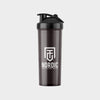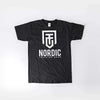What is a lifting belt?
A lifting belt is designed to provide firm and reliable support around your waist and torso during heavy lifts. The belt helps to stabilize the spine and reduce the strain on the lower part of the back, which in turn leads to safer and more efficient lifting technique.
When you inhale deeply and tense your abdominal muscles against the belt, you create a significant increase in abdominal pressure. This pressure supports the spine from the inside, allowing you to maintain a strong and safe position throughout the lift. The increased pressure improves your body mechanics and enables you to generate more power through the lift. It's this mechanism that makes many experience that they can lift more weight when using a training belt.
The use of a weightlifting belt is particularly popular among powerlifters, Strongman, Crossfit practitioners, and other experienced athletes. These individuals place extremely high demands on their body and often lift weights that are at the limit of what's possible. For them, the belt is not just an aid; it's a necessity to continue developing and stay injury-free.
When should you use a lifting belt?
The use of a lifting belt is particularly beneficial during most heavy leg exercises and in deadlifts, but also in a variety of other exercises that require extra core stability. It's important to note that a weightlifting belt doesn't replace the need for strong core muscles, but rather complements and enhances the existing strength and stability.
In addition to lifting belts,
lifting straps can also be a valuable accessory – especially when training deadlifts with heavy weights. Lifting straps improve your grip, making it possible to lift heavier and more controlled without your grip strength becoming a limiting factor.
Choosing the right time to use your training belt is a balancing act. Listen to your body and use the belt as a supportive tool when needed. When used correctly, a lifting belt can become a valuable part of your training routine, helping you improve performance and potentially prevent injuries. Remember to always work on improving your technique and core strength – with or without a weightlifting belt.
How do you use a lifting belt?
To fully benefit from your lifting belt, correct placement and use are crucial. Generally, the belt should be placed around the waist, focusing on the lumbar region. The buckle should be positioned over the lower abdominal muscles, approximately at navel height, for optimal support and control. It's important to avoid placing the belt too low, especially when performing exercises like squats or deadlifts, as this can reduce its effectiveness and comfort.
Adjustment is key when it comes to using a weightlifting belt. It might take some time to get used to the feeling and find the position that provides the best support for your body and the specific exercises you're performing. For instance, you might need to adjust the belt's position between squats and deadlifts. Listen to your body and experiment with different placements to find what works best for you.
Training belts are designed with several holes for easy adjustment to your body and the demands of the exercise. As you increase weights during your session, it may be appropriate to tighten the belt more for increased support. But remember, the belt should be tight enough to create pressure but not so tight that it hinders movement or breathing.
The breathing technique is also a critical aspect of using a lifting belt effectively. Creating what's called intra-abdominal pressure is a technique where you breathe deeply into your abdomen and hold your breath during the lift, increasing the pressure in the abdomen and providing a stabilizing effect. Think of your belt as a support for this technique. When you "blow up the balloon" – that is, tense your abdomen and core muscles – the belt creates resistance that further increases the pressure and stability.
Why should you use training belts?
Training belts are a useful accessory to have at the gym, whether you're a beginner or experienced. They can help you achieve better results in your lifts, increase your strength, and improve your technique. Here are some reasons why you should consider using a lifting belt:
-
Provides support for the back: Training belts provide extra support for the back during heavy lifts, which can help you avoid injuries and increase your performance. A weightlifting belt can also help you keep your back straight during the lift.
-
Increased pressure on the abdominal muscles: By using a weightlifting belt, you can increase the pressure on the abdominal muscles, which can lead to a more intense workout and better results.
-
Increases performance: By having a lifting belt in place, you can increase your performance during heavy lifts. It can help you complete more repetitions and use heavier weights, which can contribute to increasing your strength and muscle growth.
-
Increases motivation: Training belts can also help you feel more confident and motivated during your workout, as you can perform more and challenge yourself with heavier weights. This can lead to better training results and increased self-confidence.
In summary, the reasons to use weightlifting belts are that they are an excellent tool for providing support, increased confidence, more intense training, better results, increased strength, muscle growth, and can help you avoid injuries.
How should a lifting belt fit?
Finding the right way to wear a lifting belt is fundamental to maximizing its benefits during strength training. When you first get your belt, it's important to test it in a comfortable environment, such as at home, to understand how it feels around your waist and how tight it should be. Remember that the fit can vary depending on the exercise, so be prepared to adjust the belt accordingly.
A lifting belt should sit around the waist. It should be placed over the navel and extend over the lower back to provide optimal support. It's important that the belt is tight enough to create the desired intra-abdominal pressure, but not so tight that it restricts your breathing or movement. A good rule to follow is that you should be able to breathe in deeply into your belly without feeling uncomfortable restrictions.
Your clothing also affects how your training belt will fit. The thickness of your clothes can influence which hole you use on the belt. A thick hoodie, for example, might require a looser setting compared to a day when you're wearing a thinner shirt. Therefore, it's important to adjust the belt based on your clothing for the day to ensure that it both feels comfortable and provides the right support.
Getting used to a weightlifting belt can take some time, and it's normal to feel uncomfortable at first. Give yourself time to experiment with different settings and exercises. When you find the right fit and become comfortable using the belt, you will notice a noticeable difference in your ability to perform heavy lifts with improved technique and greater safety.
What are the benefits of a lifting belt?
The benefits of using a lifting belt are many and vary depending on individual needs and goals. One of the primary benefits is improved stability and can reduce the risk of back injuries. When the belt is correctly placed and used, it helps to stabilize the spine by increasing intra-abdominal pressure. This pressure acts as a supporting force from within, helping to keep the spine in a neutral and safe position during heavy lifts.
Another significant benefit is the ability to lift heavier weights. With the increased pressure around the torso, you can generate more power during the lift, leading to better performance. This is especially true for exercises like deadlifts and squats, where core stability is crucial.
Additionally, a training belt can contribute to improving technique. By providing physical support, it helps you maintain proper form throughout the exercise. This is particularly important when working with maximal lifts or when fatigue begins to affect your ability to maintain good form. A belt can act as a reminder to keep the body in the right positions and engaged.
However, it's important to note that a weightlifting belt does not replace the need for strong core muscles and proper lifting technique. It should be used as a complement to, not a replacement for, good training and technique.
In summary, a lifting belt offers several benefits, including improved stability, lifting heavier weights, and better technique.
Do we have training belts for women?
Our range of training belts are designed for both women and men, and we offer a variety of sizes. There's no reason to believe that women need a special belt to get the most out of their strength training. Our lifting belts are designed to provide support for the back during heavy lifts. This is particularly important for people performing lifts that can cause strain on the back, such as deadlifts or squats.
Whether you are a man or a woman, you have the same need for back support during heavy lifts. Therefore, you don't need a specially designed training belt for women - all weightlifting belts from us work equally well for everyone, regardless of gender.
The most important thing is to choose a belt that feels comfortable and provides support where needed. We have training belts in various sizes and materials to offer something that suits you. So whether you are a man or a woman, you can find a training belt that meets your needs and helps you perform your best.
Better experience with weightlifting belts
To take your training to the next level, a quality weightlifting belt, also known as a lifting belt or training belt, is a crucial component. These belts are more than just an accessory; they are an investment in your performance and safety. A well-chosen weightlifting belt provides support and stability where it's needed most, especially during heavy lifts.
When choosing the right weightlifting belt, it's important to consider both quality and fit. A lifting belt that is tailored to your body shape and training needs not only provides better support but also a more comfortable and safer workout. It should feel natural around your waist, strengthen your core stability, and allow you to focus on your technique.
The use of a weightlifting belt can dramatically improve your experience at the gym. It can protect your back by reducing the strain and helping you maintain proper posture throughout the lift. This means not just a safer workout but also the opportunity to perform better and achieve your goals faster.
A weightlifting belt is also an excellent tool for increasing awareness of your body posture and form. By providing a reminder to activate your core, a training belt can help you perform each exercise with maximum efficiency and minimal risk. Whether you're experienced or just starting your training journey, the right weightlifting belt can make a significant difference.
Choosing the right training belt for the gym
Choosing the right training belt for the gym is important to ensure you have support and stability during your workout. Our products, the neoprene belt, weightlifting belt, functional lifting belt, and lever belt, are all designed to provide maximum support and comfort during heavy lifts. Here are some of the most significant differences and benefits between our various weightlifting belts:
-
Neoprene belt: Perfect to use for compression and support for the lower back during strength training, and it can also be used as an under belt for our other training belts.
-
Weightlifting belt: Specially designed for weightlifting such as snatch and clean and jerk, this weightlifting belt provides strong support for the lower back.
-
Functional lifting belt: Flexible weightlifting belt made of durable EVA material, complete with Velcro for easy adjustment. It's ideal for lifts that require extra mobility, making it perfect for the dynamic exercises in Crossfit and the challenging Strongman exercises like Atlas stones.
-
Lever belt: Thicker lifting belt made of genuine leather that provides a lot of support for the lower back and gives you the ability to create a significant intra-abdominal pressure which is optimal for, for example, deadlifts or squats.
lifting belts for men and women
Discover our lifting and training belts, designed for both men and women, offering maximum stability and comfort during strength training. Regardless of gender or training level, our belts provide the perfect fit and adjustability, so you can lift heavy with safety and confidence. Choose from durable leather, flexible functional belts, or comfortable neoprene options – all created to suit both men and women equally well. Take your training to the next level with lifting belts that truly fit everyone!
 Lifting Straps
Lifting Straps Lifting Belts
Lifting Belts Nordic Grips
Nordic Grips Knee Sleeves
Knee Sleeves Elbow Sleeves
Elbow Sleeves Wrist Wraps
Wrist Wraps Knee Wraps
Knee Wraps Smelling Salt
Smelling Salt Supplements
Supplements  Neoprene Shorts
Neoprene Shorts Grip Shirt
Grip Shirt Deadlift socks
Deadlift socks Gym Chalk
Gym Chalk  Lifting Shoes
Lifting Shoes Strongman Tacky
Strongman Tacky Stone Sleeves
Stone Sleeves Sandbags
Sandbags Calf & Shin Sleeves
Calf & Shin Sleeves Compression Cuffs
Compression Cuffs Accessories
Accessories
 Best Seller
Best Seller Sale
Sale News
News Lifting Straps
Lifting Straps Lifting Belts
Lifting Belts Nordic Grips
Nordic Grips Knee Sleeves
Knee Sleeves Elbow Sleeves
Elbow Sleeves Wrist Wraps
Wrist Wraps Knee Wraps
Knee Wraps Smelling Salt
Smelling Salt Supplements
Supplements  Neoprene Shorts
Neoprene Shorts Grip Shirt
Grip Shirt Deadlift socks
Deadlift socks Gym Chalk
Gym Chalk  Lifting Shoes
Lifting Shoes Strongman Tacky
Strongman Tacky Stone Sleeves
Stone Sleeves Sandbags
Sandbags Calf & Shin Sleeves
Calf & Shin Sleeves Compression Cuffs
Compression Cuffs Accessories
Accessories



 Lifting Straps
Lifting Straps Lifting Belts
Lifting Belts Nordic Grips
Nordic Grips Knee Sleeves
Knee Sleeves Elbow Sleeves
Elbow Sleeves Wrist Wraps
Wrist Wraps Knee Wraps
Knee Wraps Smelling Salt
Smelling Salt Neoprene Shorts
Neoprene Shorts Grip Shirt
Grip Shirt Deadlift socks
Deadlift socks Lifting Shoes
Lifting Shoes Strongman Tacky
Strongman Tacky Stone Sleeves
Stone Sleeves Sandbags
Sandbags Calf & Shin Sleeves
Calf & Shin Sleeves Compression Cuffs
Compression Cuffs Accessories
Accessories









